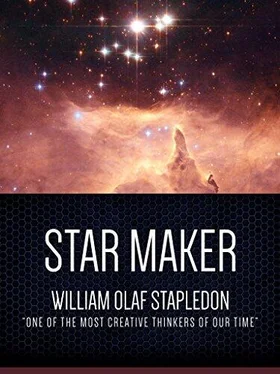When several invading expeditions had been thus circumvented, there arose among the worlds of the mad United Empires a tradition that certain seemingly pacific worlds were in fact more dangerous than all other enemies, since plainly they had a strange power of "poisoning the soul." The imperialists determined to annihilate these terrible opponents. The attacking forces were instructed to avoid all telepathic parley and blow the enemy to pieces at long range. This, it was found, could be most conveniently performed by exploding the sun of the doomed system. Stimulated by a potent ray, the atoms of the photosphere would start disintegrating, and the spreading fury would soon fling the star into the "nova" state, roasting all his planets.
It was our lot to witness the extraordinary calm, nay the exaltation and joy with which these worlds accepted the prospect of annihilation rather than debase themselves by resistance. Later we were to watch the strange events which saved this galaxy of ours from disaster. But first came tragedy.
From our observation points in the minds of the attackers and the attacked, we observed not once but three times the slaughter of races nobler than any that we had yet encountered by perverts whose own natural mental rank was almost as high. Three worlds, or rather systems of worlds, each possessed by a diversity of specialized races, we saw annihilated. From these doomed planets we actually observed the sun break out with tumultuous eruption, swelling hourly. We actually felt, through the bodies of our hosts, the rapidly increasing heat, and through their eyes the blinding light. We saw the vegetation wither, the seas begin to steam. We felt and heard the furious hurricanes which wrecked every structure and bowled the ruins before them. With awe and wonder we experienced something of that exaltation and inner peace with which the doomed angelic populations met their end. Indeed, it was this experienced angelic exaltation in the hour of tragedy that gave us our first clear insight into the most spiritual attitude to fate. The sheer bodily agony of the disaster soon became intolerable to us, so that we were forced to withdraw ourselves from those martyred worlds. But we left the doomed populations themselves accepting not only this torture but the annihilation of their glorious community with all its infinite hopes, accepting this bitterness as though it were not lethal but the elixir of immortality. Not till almost the close of our own adventure did we grasp for a moment the full meaning of this ecstasy.
It was strange to us that none of these three victims made any attempt to resist the attack. Indeed, not one inhabitant in any of these worlds considered for a moment the possibility of resistance. In every case the attitude to disaster seemed to express itself in such terms as these: "To retaliate would be to wound our communal spirit beyond cure. We choose rather to die. The theme of spirit that we have created must inevitably be broken short, whether by the ruthlessness of the invader or by our own resort to arms. It is better to be destroyed than to triumph in slaying the spirit. Such as it is, the spirit that we have achieved is fair; and it is indestructibly woven into the tissue of the cosmos. We die praising the universe in which at least such an achievement as ours can be. We die knowing that the promise of further glory outlives us in other galaxies. We die praising the Star Maker, the Star Destroyer."
4. TRIUMPH IN A SUB-GALAXY
It was after the destruction of the third system of worlds, when a fourth was preparing for its end, that a miracle, or a seeming miracle, changed the whole course of events in our galaxy. Before telling of this turn of fortune I must double back the thread of my story and trace the history of the system of worlds which was now to play the leading part in galactic events.
It will be remembered that in an outlying "island" off the galactic "continent" there lived the strange symbiotic race of Ichthyoids and Arachnoids. These beings supported almost the oldest civilization in the galaxy. They had reached the "human" plane of mental development even before the Other Men; and, in spite of many vicissitudes, during the thousands of millions of years of their career they had made great progress. I referred to them last as having occupied all the planets of their system with specialized races of Arachnoids, all of which were in permanent telepathic union with the Ichthyoid population in the oceans of the home planet. As the ages passed, they were several times reduced almost to annihilation, now by too daring physical experiments, now through too ambitious telepathic exploration; but in time they won through to a mental development unequaled in our galaxy. Their little island universe, their outlying cluster of stars, had come wholly under their control. It contained many natural planetary systems. Several of these included worlds which, when the early Arachnoid explorers visited them telepathically, were found to be inhabited by native races of pre-utopian rank. These were left to work out their own destiny, save that in certain crises of their history the Symbiotics secretly brought to bear on them from afar a telepathic in-fluence that might help them to meet their difficulties with increased vigor. Thus when one of these worlds reached the crisis in which Homo sapiens now stands, it passed with seem-ingly natural ease straight on to the phase of world-unity and the building of Utopia. Great care was taken by the Symbiotic race to keep its existence hidden from the primitives, lest they should lose their independence of mind. Thus, even while the Symbiotics were voyaging among these worlds in rocket vessels and using the mineral resources of neighboring uninhabited planets, the intelligent worlds of pre-utopian rank were left unvisited. Not till these worlds had themselves entered the full Utopian phase and were exploring their neighbor planets were they allowed to discover the truth. By then they were ready to receive it with exultation, rather than disheartenment and fear. Thenceforth, by physical and telepathic intercourse the young-utopia would be speedily brought up to the spiritual rank of the Symbiotics themselves, and would cooperate on an equal footing in a symbiosis of worlds.
Some of these pre-utopian worlds, not malignant but incapable of further advance, were left in peace, and preserved, as we preserve wild animals in national parks, for scientific interest. Aeon after aeon, these beings, tethered by their own futility, struggled in vain to cope with the crisis which modern Europe knows so well. In cycle after cycle civilization would emerge from barbarism, mechanization would bring the peoples into uneasy contact, national wars and class wars would breed the longing for a better world-order, but breed it in vain. Disaster after disaster would undermine the fabric of civilization. Gradually barbarism would return. Aeon after aeon, the process would repeat itself under the calm telepathic observation of the Symbiotics, whose existence was never suspected by the primitive creatures under their gaze. So might we ourselves look down into some rock-pool where lowly creatures repeat with naive zest dramas learned by their ancestors aeons ago.
The Symbiotics could well afford to leave these museum pieces intact, for they had at their disposal scores of planetary systems. Moreover, armed with their highly developed physical sciences and with sub-atomic power, they were able to construct, out in space, artificial planets for permanent habitation. These great hollow globes of artificial super-metals, and artificial transparent adamant, ranged in size from the earliest and smallest structures, which were no bigger than a very small asteroid, to spheres considerably larger than the Earth. They were without external atmosphere, since their mass was generally too slight to prevent the escape of gases. A blanket of repelling force protected them from meteors and cosmic rays. The planet's external surface, which was wholly transparent, encased the atmosphere. Immediately beneath it hung the photosynthesis stations and the machinery for generating power from solar radiation. Part of this outer shell was occupied by astronomical observatories, machinery for controlling the planet's orbit, and great "docks" for interplanetary liners. The interior of these worlds was a system of concentric spheres supported by girders and gigantic arches. Interspersed between these spheres lay the machinery for atmospheric regulation, the great water reservoirs, the food factories and commodity-factories, the engineering shops, the refuse-conversion tracts, residential and recreational areas, and a wealth of research laboratories, libraries and cultural centers. Since the Symbiotic race was in origin marine, there was a central ocean where the profoundly modified, the physically indolent and mentally athletic descendants of the original Ichthyoids constituted the "highest brain tracts" of the intelligent world. There, as in the primeval ocean of the home planet, the symbiotic partners sought one another, and the young of both species were nurtured. Such races of the sub-galaxy as were not in origin marine constructed, of course, artificial planets which, though of the same general type, were adapted to their special nature. But all the races found it also necessary to mold their own nature drastically to suit their new conditions. As the aeons advanced, hundreds of thousands of worldlets were constructed, all of this type, but gradually increasing in size and complexity. Many a star without natural planets came to be surrounded by concentric rings of artificial worlds. In some cases the inner rings contained scores, the outer rings thousands of globes adapted to life at some particular distance from the sun. Great diversity, both physical and mental, would distinguish worlds even of the same ring. Sometimes a comparatively old world, or even a whole ring of worlds, would feel itself outstripped in mental excellence by younger worlds and races, whose structure, physical and biological, embodied increasing skill. Then either the superannuated world would simply continue its life in a sort of backwater of civilization, tolerated, loved, studied by the younger worlds; or it would choose to die and surrender the material of its planet for new ventures.
Читать дальше









![Олаф Стэплдон - Создатель звезд [сборник litres]](/books/433148/olaf-stepldon-sozdatel-zvezd-sbornik-litres-thumb.webp)


